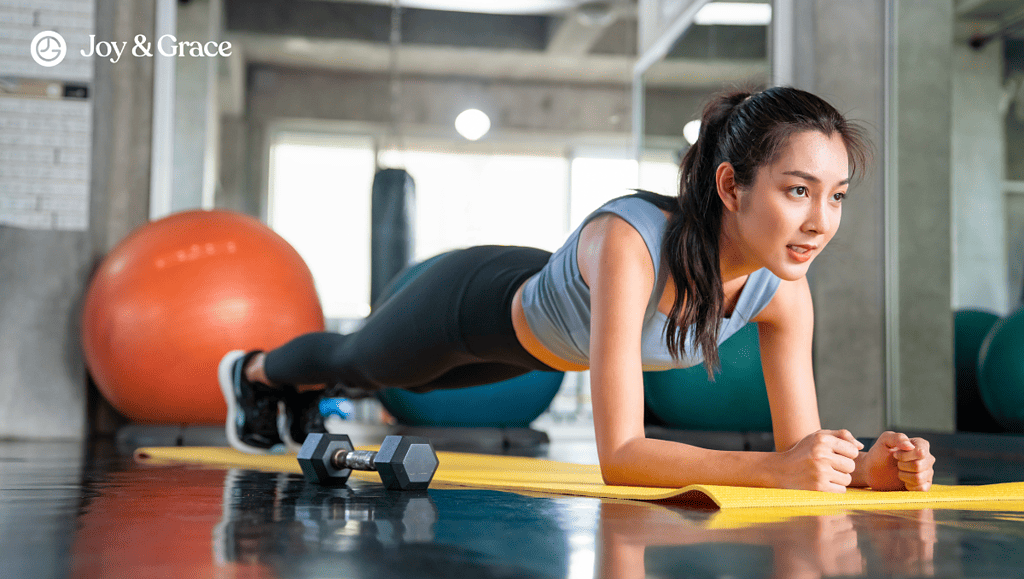Are you tired of experiencing shoulder pain whenever you try to conquer that plank exercise during your workout routine? You're not alone. Many health enthusiasts struggle with shoulder pain from planks. And this discomfort can hinder your wellness journey.
This guide will delve into the possible reasons behind shoulder pain during planks. We'll also share some practical tips to perform them painlessly. So, say goodbye to shoulder pain during planks and prepare to feel empowered toward a healthier, pain-free lifestyle.
Can Planking Cause Shoulder Pain?
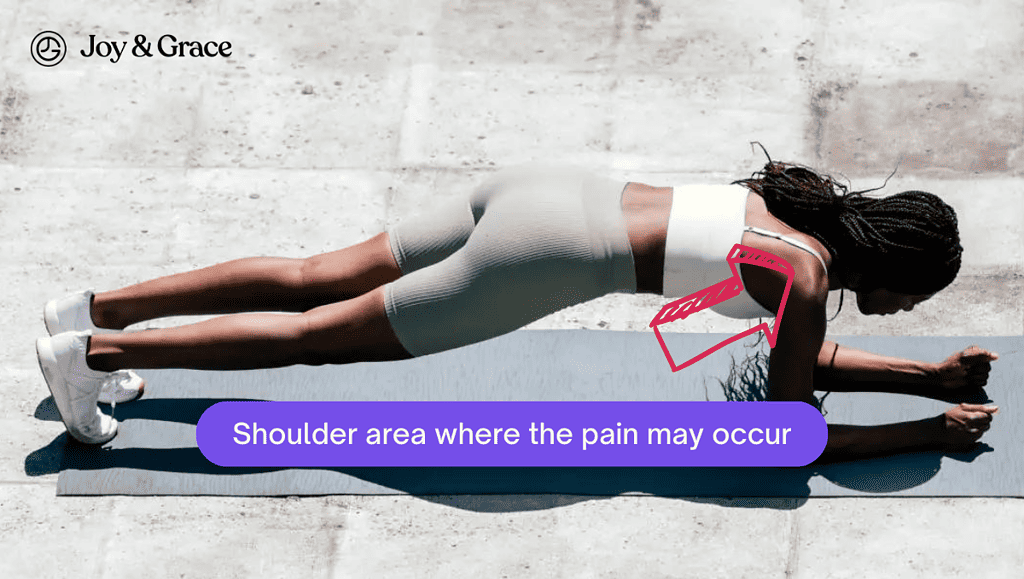
Planks are a popular core exercise that requires you to hold a position similar to a push-up but with your forearms on the ground. Planks can be highly effective for building core strength and toning your body. However, some people may experience shoulder pain during the exercise.
This may be anecdotal, though, since we found only one study on planks causing shoulder pain. As stated by the study, planks performed with too little intensity or excessively high intensity can cause shoulder pain.
So if you’re experiencing shoulder pain from planks, you may have the wrong technique. Shoulder pain during planks is not normal and is usually due to poor form (not engaging your muscles enough) or overstrain.
To add more confusion, some studies suggest that planks can actually help with shoulder pain if done properly. We’ll touch on that later.
Can Side Planks Cause Shoulder Pain?
Yes, side planks can cause shoulder pain.
Side planks are excellent for targeting the obliques.
However, sometimes it may seem as though your shoulders are bearing more strain than your torso. You might sense an unsettling feeling, like your shoulder might give way, or perhaps there's an unusual trembling sensation. This is primarily because the side plank position channels a considerable amount of your body weight onto the shoulder, putting it under stress.
Considering this, if you're experiencing such discomfort, it may be beneficial to switch to a simpler plank version, called the bent knee plank. This modification allows your legs to provide additional stability, focusing the exercise more on your core and relieving some pressure from the shoulder.
We've detailed the steps for executing the bent knee side plank further down in the article.
Why Does Planking Cause Shoulder Pain?
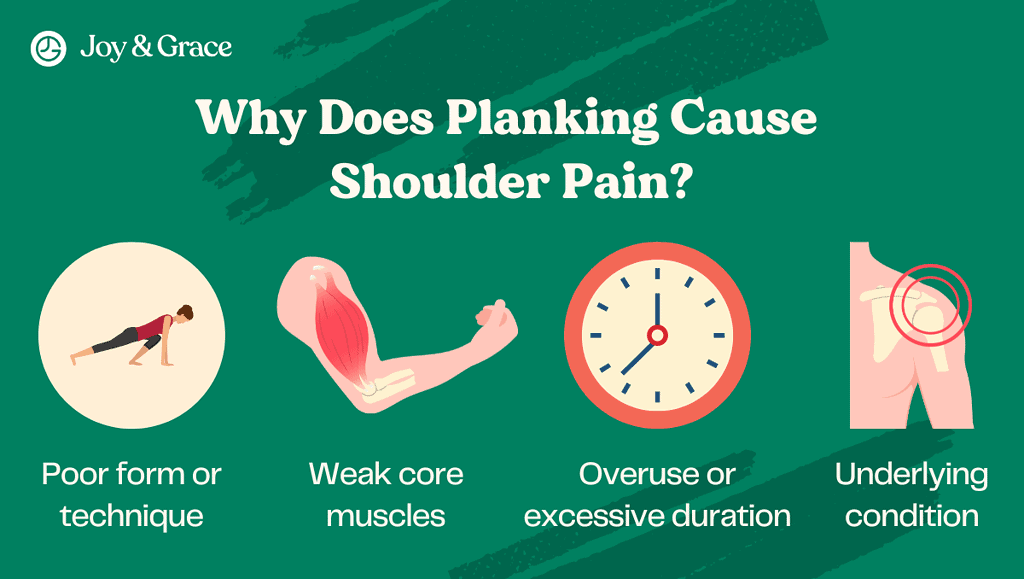
Here are a few possible reasons why planking may lead to shoulder pain:
- Poor form or technique
Incorrect positioning of the arms or shoulders during planking can stress the shoulder joints. This can strain the muscles, tendons, and ligaments surrounding the shoulders, leading to pain.
- Weak core muscles
Planking requires a certain level of strength to maintain proper alignment and stability. If your core muscles are weak, the burden of supporting your weight during planking will fall on your shoulders. This additional weight on the shoulders can increase strain and may even lead to injury.
In fact, this direct relationship between a weak core and shoulder problems is also supported by research.
In one study, athletes with shoulder dysfunction had poorer core stability. And the worse the athletes' shoulder problems were, the worse their performance in tests that assessed their core stability.
- Overuse or excessive duration
Even if your core is strong, performing planks too long or too frequently can still lead to shoulder problems. This can occur through the mechanism we mentioned earlier. When the core can no longer support your body weight, all the burden will fall on the shoulders, and the pain will follow.
- Underlying shoulder condition
Finally, shoulder pain during planks can sometimes also be attributed to an underlying shoulder condition.
Shoulders aren't the primary point of load during planks. However, even a minor strain can worsen a shoulder injury or condition.
The following conditions can be worsened by the stress placed on the shoulders during plank exercises:
-
- Rotator cuff injuries
- Bursitis
- Shoulder impingement syndrome
Is It Normal To Feel Shoulder Pain After Planking?
While some muscle soreness is normal after exercise, sharp or intense pain should not be ignored. Listening to your body and distinguishing between discomfort and pain is essential.
Is The Plank Good For My Shoulders?
As we mentioned earlier, planks may actually be beneficial for your shoulders if done correctly. By strengthening your core, you are also improving your shoulder health. This is because the core is also part of the upper kinetic chain.
Imagine your body is a chain, with each segment connected. When you do activities like throwing, the force generated by the action moves from one part of your body to another.
The core is at the center of this chain and is vital in generating and transferring the force from the center of your body into your extremities. And this includes your shoulders too.
According to a study, the abdominal muscles showed high levels of activation during various shoulder movements.
In summary, planks can be a valuable exercise for shoulder health by strengthening the core and improving overall stability when performed correctly. Remember to prioritize proper form and seek guidance if needed to optimize the benefits while minimizing the risk of injury.
Do Planks Increase Shoulder Strength?
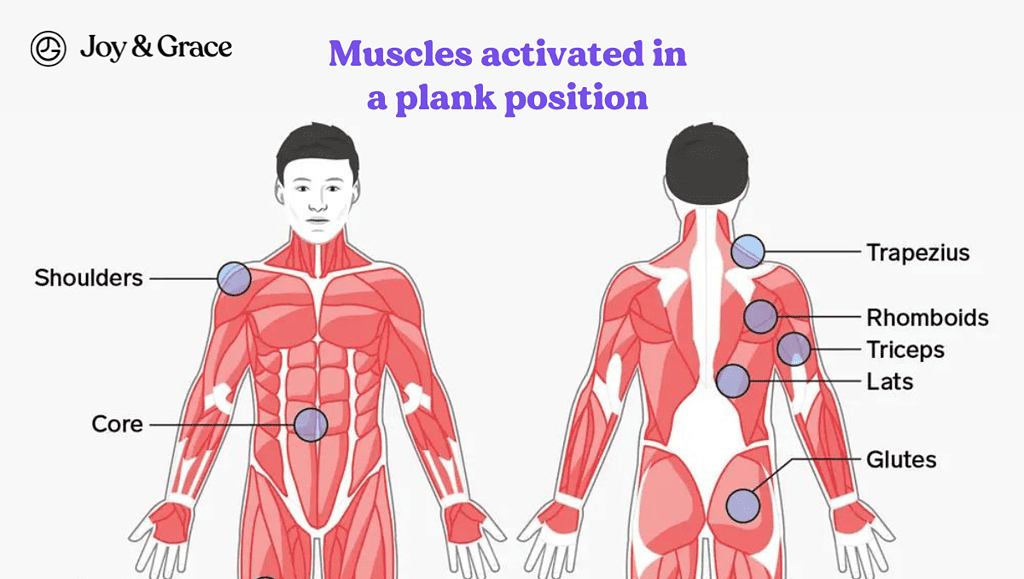
Although planks are mainly a core exercise, they require the use of other muscles to help stabilize your body. When you perform a plank, your shoulders also bear some of the upper body's weight. This could help strengthen the muscles in that area.
Holding the plank position engages the muscles surrounding the shoulder joints. Over time, regular plank exercises can help improve stability and overall strength in the shoulders.
But remember: putting too much weight on your shoulders can cause strain and even injury if you're not strong enough to handle it. By listening to your body and keeping good form, you can strengthen your shoulders without putting too much strain on them.
Are Planks Good For The Rotator Cuffs?
Yes, planks can be beneficial for the rotator cuffs. The rotator cuff is a group of muscles and tendons that help stabilize and control the movement and range of motion of the shoulder joint.
A study suggests that incorporating core exercises (such as side planks and front planks) with shoulder exercises can help athletes with shoulder injuries recover and return to sports activities.
According to another study, people with rotator cuff repair surgery had weaker core endurance and poorer upper extremity performance than healthy individuals of similar age. The researchers also suggest that including core exercises after surgery could be helpful.
While planks can benefit a healthy rotator cuff, it is important to note that planks would not be recommended if you have an injured rotator cuff. In such cases, exercises targeting the rotator cuff muscles should be a priority for rehabilitation. And these should be done under the guidance of a healthcare professional or physical therapist.
Treatment Options For Shoulder Pain From Planks
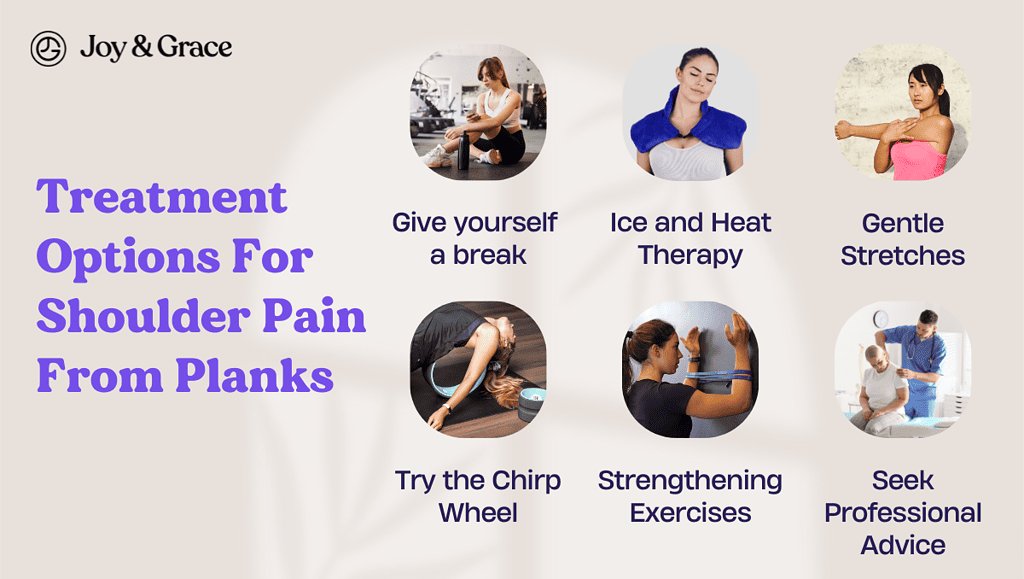
If you experience shoulder pain from planks, there are several treatment options available to relieve it. Here are some easy ways to get rid of the pain:
- Give yourself a break
Give your shoulders a break from planks and any other exercises that exacerbate the pain.
- Ice and Heat Therapy
Applying ice packs wrapped in a cloth to the affected area for 15-20 minutes can help reduce inflammation and pain. After a couple of days, you can switch to heat therapy using a warm towel or a heating pad to improve blood circulation and relax the muscles.
- Gentle Stretches
Perform gentle shoulder stretches to improve flexibility and relieve tension. Examples include shoulder rolls, cross-body arm stretches, and gentle neck stretches. Be sure to perform these exercises with proper form and without exacerbating the pain.
- Try the Chirp Wheel
This unique tool alleviates muscle knots and tension in your neck, shoulders, and back. Lie on it with your shoulders aligned with the center of the wheel, and roll gently back and forth to release tension.
- Strengthening Exercises
Slowly incorporate shoulder-strengthening exercises into your routine. This can help improve the stability and strength of your shoulder.
Consult with a healthcare provider to ensure you're performing the exercises correctly.
- Seek Professional Advice
If the pain persists or worsens, it's advisable to consult a healthcare professional. They can assess your condition and offer personalized guidance for your shoulder pain.
Remember, it's essential to listen to your body and not push through severe pain. Allow yourself time to heal and gradually reintroduce planks once you've recovered.
How Do I Prevent Shoulder Pain While Planking?
Here are some tips to prevent shoulder pain while planking:
- Maintain Proper Shoulder Alignment
Align your shoulders directly above your wrists and keep your body straight from head to heels. Avoid sagging or arching your back, as this can stress your shoulders unnecessarily.
- Engage Core Muscles
Focus on engaging your core muscles throughout the plank. A strong core can help distribute the load and reduce strain on your shoulders.
- Gradual Progression
Start with shorter plank durations and gradually increase the time as your strength improves. Avoid overdoing it, especially if you're a beginner or have a history of shoulder issues.
- Warm-up
Before planking, warm up your shoulder and core muscles with dynamic stretches or light exercises. This helps prepare the muscles for the plank and reduces the risk of injury.
- Listen to Your Body
If you experience any sharp or persistent pain, stop the exercise. It's important to respect your body's limits and not push through excessive discomfort.
Don't be discouraged as a beginner. Strengthening your core with planks is still possible. Start with modified variations and gradually progress. Focus on proper technique and consider incorporating other core exercises. Patience and consistency will lead to progress.
How Do I Know If I'm Planking Correctly?
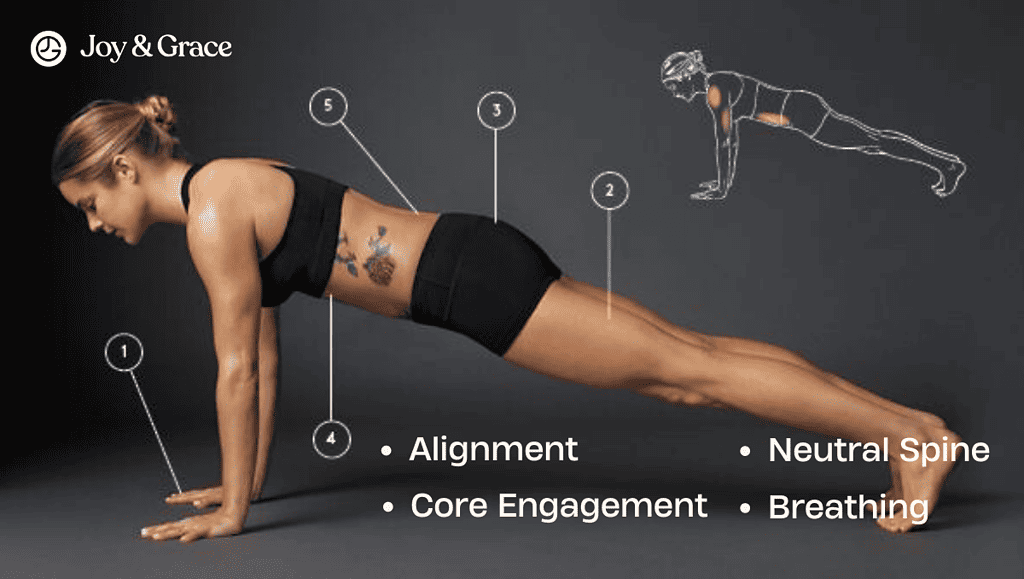
To ensure you're performing planks correctly, pay attention to the following cues:
- Alignment
Your shoulders should be directly above your wrists, forming a straight line. Avoid hunching or rounding your shoulders.
- Core Engagement
Maintain a strong and engaged core throughout the exercise. Imagine pulling your belly button towards your spine to activate the deep abdominal muscles.
- Neutral Spine
Keep your spine in a neutral position, avoiding excessive arching or rounding. Your body should form a straight line from head to heels. The bottom tips of the shoulder blades should press toward your back ribs, encouraging a lift and opening in the chest.
- Breathing
Breathe steadily throughout the plank, avoiding shallow or held breaths. Inhale deeply through your nose and exhale through.
Modifications And Alternatives To Planks For Shoulder Pain
You can do some modifications and alternative exercises to help achieve your fitness goals. These exercises can help you continue working on your core without hurting your shoulders. Consider the following options:
- Knee Planks
Instead of performing planks on your toes, start on your knees. This modification reduces the load on your shoulders while still engaging your core muscles. Focus on maintaining a straight line from your knees to your head.
- Forearm Planks
Perform planks on your forearms rather than your hands. Instead of your hands being the base of the front of the plank, your forearms will be the base. This gives you a larger area on which to spread the weight. This variation can decrease the strain on your shoulders while still providing an effective core workout. Make sure your elbows are directly below your shoulders and maintain a straight body alignment.
- Stand facing a wall and place your hands on the wall at shoulder height.
- Lean forward until your body forms a straight line, engaging your core.
This takes some of the pressure off your shoulders while allowing you to work on core stability.
- Start on all fours with your hands directly under your shoulders and knees under your hips.
- Extend one arm forward and the opposite leg backward while maintaining a stable core.
This exercise targets core strength and stability without the same level of shoulder stress as planks.
Another modification or alternative to traditional planks is side planks. Side planks primarily target the core muscles while also engaging the shoulder muscles.
- To perform a side plank, start by lying on your side with your forearm resting on the ground, elbow directly beneath your shoulder. This will be your starting position.
- Stack your feet on top of each other or stagger them for better stability.
- Lift your hips off the ground, creating a straight line from your head to your heels.
- Hold the position for as long as you can while maintaining proper form.
Remember to start with shorter durations. You can gradually increase the time as you build strength and improve shoulder stability. Listen to your body and adjust the exercises as needed to avoid pain or discomfort.
Takeaway
If you're experiencing shoulder pain from doing planks, it's essential to address it to prevent potential injury. Here are a few key takeaways to keep in mind:
- Proper form is crucial
- Modify the exercise
- Strengthen supporting muscles
- Warm up and stretch
- Listen to your body
Remember, it's essential to prioritize your body's well-being and adjust your exercise routine as needed.
Don't let shoulder pain hold you back from achieving your fitness goals. Subscribe to our Joy & Grace newsletter and stay updated with the latest insights to lead a healthier, pain-free lifestyle. Join our community today and take the first step toward a stronger, more resilient you.
